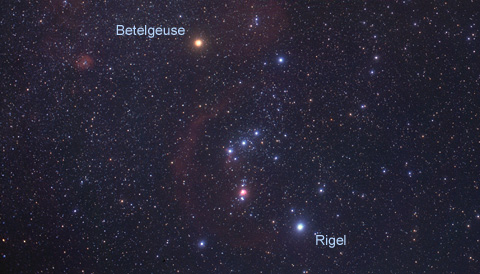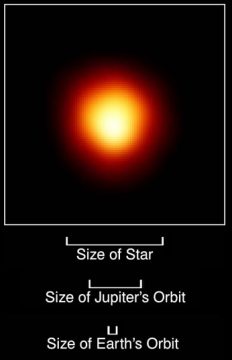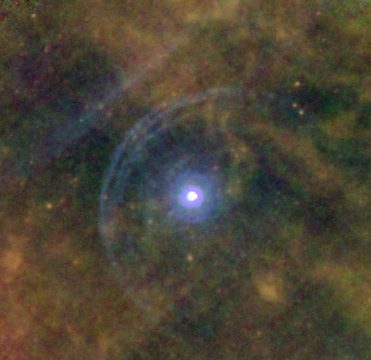Astronomy - Did Betelgeuse Swallow Its Companion?
The red supergiant marking Orion's shoulder seems to be spinning too fast. Did it get a boost when merged with a smaller companion star 100,000 years ago?

Orion, the Hunter, is a hallmark of northern winter skies. The red supergiant star Betelgeuse marks one of his shoulders.
Akira Fujii
Akira Fujii
This much is clear: Someday Betelgeuse will explode as a supernova. It's roughly 650 light-years away — and when it goes, it'll be spectacular.
But astronomers can't estimate when that might happen, because virtually everything known about this star is uncertain. Its surface temperature, mass, luminosity, and even its distance aren't pinned down very well.
Those loose ends have nagged at J. Craig Wheeler, a colorful theorist and supernova specialist at the University of Texas, who has long been "obsessed with the uncertainty in the evolutionary state of Betelgeuse." But to narrow the date range for the star's eventual demise, he needs tighter constraints on its basic characteristics. Wheeler and an international team of undergraduate students have mounted an effort called the "Betelgeuse Project" to try to do that, and their results appear in an article published December 19th in the Monthly Notices of the Royal Astronomical Society.
Best guesses, as put forward earlier this year by Michelle Dolan (University of Notre Dame) and others, are that Betelgeuse has 19 times the Sun's mass (somewhat larger than previously assumed), 126,000 times its energy output, a surface temperature of 3500 kelvin, and a diameter of at least 1.2 billion kilometers — big enough to gobble up everything to the outer fringe of our asteroid belt and maybe even Jupiter too.

Astronomers first determined the diameter of Betelgeuse in 1920, but it wasn't until 1995 that the Hubble Space Telescope recorded the supergiant star's swollen disk.
A. Dupree / R. Gilliland / NASA / ESA
A. Dupree / R. Gilliland / NASA / ESA
These guesstimates are all tied to how far away the star is, and for now we don't know that more accurately than to about ±25%. Another complication is that astronomers can resolve the disk of Betelgeuse (it's about 0.05 arcsecond across) — but, again, the true value is uncertain.
And don't expect the European Space Agency's Gaia astrometry mission to pinpoint this star's distance. Betelgeuse is too bright for the spacecraft's sensitive sensors. Gaia can use a small filter to dim the light of stars brighter than magnitude 3, explains project scientist Timo Prusti, but the stars' centers still saturate. The "extremely challenging" analysis and reduction of these small images will take time, Prusti says, with "quite some patience needed."
Another key characteristic is how fast Betelgeuse's bloated outer envelope spins. The blue- and redshifting of its spectrum (one limb is moving toward us, while the one on the opposite side is moving away), combined with a tilt to our line of sight of about 20°, yields a rotation speed along the equator of about 15 km per second. In its youth Betelgeuse must have spun much faster, perhaps as fast as 250 km/s. But like a spinning figure skater who flings her arms outward to slow down, the swelling of Betelgeuse as it became a red supergiant and the gradual loss of angular momentum via outflowing stellar winds have slowed the rotation rate dramatically.
Betelgeuse is Spinning (Too) Fast
Now, 15 km/s might not seem all that fast, but for comparison the Sun's equator crawls along at just 2 km/s. Having modeled the star's evolution with various masses and spin rates, Wheeler and his student team find the 15 km/s spin to be a particularly challenging constraint that only fits "at a very special, short-lived point in the evolution" lasting a mere 1,000 years. Given that this soon-to-die star is perhaps 8 or 8½ million years old, it's highly unlikely we're seeing it at such a short blip in its lifetime.
According to Wheeler's team, one "out" could be that Betelgeuse formed as part of a binary system and that it gobbled up a 1-solar-mass companion while ballooning to its present size.
“Suppose Betelgeuse had a companion when it was first born," he muses in a University of Texas press release. "And let’s just suppose it is orbiting around Betelgeuse at an orbit about the size that Betelgeuse is now. And then Betelgeuse turns into a red supergiant and absorbs it — swallows it."
Actually, this hypothesis isn't far-fetched. Most beefy stars, those in spectral classes O or B, do form as binaries, and there's a 1-in-5 chance that the massive, solitary stars seen today are actually mergers of two paired suns into one.

This 2012 infrared image of Betelgeuse by the orbiting Herschel telescope shows shells of matter on one side of the star.
Leen Decin / ESA
Leen Decin / ESA
There might even be circumstantial evidence for Betelgeuse's gluttonous act. We've known for two decades that this star is surrounded by a double-rimmed shell of matter that lies about 7 arcminutes away. Some astronomers think it's a shock front created as the star plows through the interstellar medium. But Wheeler calculates that the shell is just about where it should be if Betelgeuse had "burped" while devouring its companion roughly 100,000 years ago.
The next step for the Betelgeuse Project will be to be to probe the star's interior using a technique called asteroseismology. This might reveal, for instance, whether a relatively dense, undissolved remnant of the sacrificial companion lies within the star's enormous volume. Stay tuned!
No comments:
Post a Comment